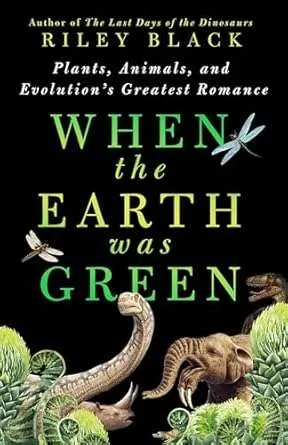JayneB Reviews / Book Reviewsbotany / dinosaurs / non-fiction / paleontology / scienceNo Comments

A gorgeously composed look at the longstanding relationship between prehistoric plants and life on Earth
Fossils plants allow us to touch the lost worlds from billions of years of evolutionary backstory. Each petrified leaf and root show us that dinosaurs, saber-toothed cats, and even humans would not exist without the evolutionary efforts of their leafy counterparts. It has been the constant growth of plants that have allowed so many of our favorite, fascinating prehistoric creatures to evolve, oxygenating the atmosphere, coaxing animals onto land, and forming the forests that shaped our ancestors’ anatomy. It is impossible to understand our history without them. Or, our future.
Using the same scientifically-informed narrative technique that readers loved in the award-winning The Last Days of the Dinosaurs, in When the Earth Was Green, Riley Black brings readers back in time to prehistoric seas, swamps, forests, and savannas where critical moments in plant evolution unfolded. Each chapter stars plants and animals alike, underscoring how the interactions between species have helped shape the world we call home. As the chapters move upwards in time, Black guides readers along the burgeoning trunk of the Tree of Life, stopping to appreciate branches of an evolutionary story that links the world we know with one we can only just perceive now through the silent stone, from ancient roots to the present.
Review
Two years ago I read another of Black’s books – “The Last Days of the Dinosaurs: An Asteroid, Extinction, and the Beginning of Our World.” In that one she mainly discussed what happened after the asteroid changed things on planet Earth and how life came back afterwards. “When the Earth was Green” does have the megafauna that grabs people’s attention but the focus of the book is on how plants, often relegated to the background, and animals have shaped each other over the course of Deep Time on planet Earth.
The prologue is beautifully written and sets up what we’re going to have presented to us and why it matters. The prologue also goes on, and on, and on. Seriously, how long is a prologue supposed to be? I was itching for the book to start way before it did.
Not gonna lie – the first chapter which explains what we know about an ancient plant that lived in the oceans, how these plants and others churned out the massive amounts of oxygen that utterly changed the evolution of life on this planet, and what chlorophyll is and does was, at times, a slog to get through. Look back over the beginning of this paragraph and note that it’s all one sentence. Black writes beautifully and poetically but her sentences can go on long enough to steep tea by.
There is also a fair amount, at least early on, of descriptions of something – plant or animal – along with little tidbits about how this plant or animal would eventually evolve into this one 50 million years later and be changed in that way. Until I got used to this, I felt as if my attention was being yanked back and forth and I was in danger of losing the plot. It shows Black’s extensive knowledge and research though. I can only imagine what reams of stuff she left out.
Much as the fossil record skips a lot, this is not a seamless flow across all the time between when plants and animals began and now. Black has selected important moments when things occurred that caused major shifts in how plants and animals evolved, the first being the above mentioned huge increase in the oxygen level. The chapters show how things were changing and how plants and animals changed each other in either a dance or an arms race.
We are talking about things that, in some cases, took place millions or billions of years ago. Knowledge has to be gleaned from what got preserved as fossils and then found, as well as how much of the fossil has been found. (If you want an interesting look at how scientists are attempting to suss out even more knowledge, look at “Explorers of Deep Time” by Roy Plotnick or “Remnants of Ancient Life” by Dave Greenwalt) Some finessing and extrapolation is done but, yes!, Black adds appendixes at the end in which she discusses why she makes the choices she does and how these are based on scientific knowledge we have. She also admits that with further discoveries, some of this will need to be amended. It’s also a book that I’m glad has some illustrations. But plants, which deserve their attention as much as megafauna, are finally and firmly brought front and center. B
~Jayne
AmazonBNKoboBook DepositoryGoogle
Related
Jayne
Another long time reader who read romance novels in her teens, then took a long break before started back again about 25 years ago. She enjoys historical romance/fiction best, likes contemporaries, action- adventure and mysteries, will read suspense if there’s no TSTL characters and is currently reading more fantasy and SciFi.







